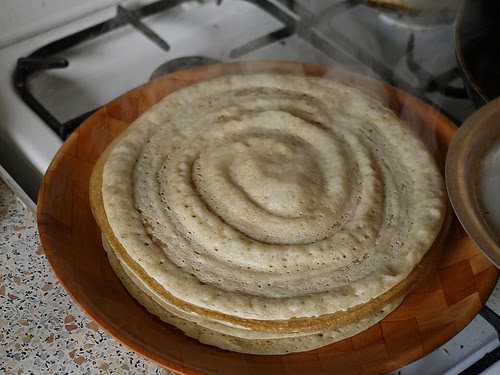Pho is a Vietnamese rice-noodle soup slow cooked with pieces
of meat (usually pork or beef). The noodles, meat, and vegetables are usually
eaten with chopsticks and then the broth is eaten with a traditional Vietnamese
soup spoon. Although the pho of today is credited to the Vietnamese, it
actually has French roots. The French occupied Vietnam from 1858 to 1954.
During their occupation they often made pot-au-feu, a slow-cooked soup of
vegetables and beef. It was not uncommon for the Vietnamese citizens to salvage
any leftovers thrown out by the French kitchens, so inevitably they discovered
pot-au-feu. Before this discovery, slow-cooking was not very popular in
Vietnam, but pot-au-feu helped the Vietnamese realize that slow-cooking was the
best method for extracting the most flavor and nutrients from food. The
Vietnamese city of Hanoi was the first to reinvent pot-au-feu. Instead of beef,
pork was used because that was more native to Vietnam. They also added flat
rice noodles and greens to the broth and then topped it off with pieces of
fried bread. They adapted the word “feu” for their creation, which is quite
fitting because the French word “feu” translates to mean “fire” in English and
usually the broth is so hot, chefs do not even bother to cook the meat before
placing it in the soup. The broth cooks it for them.
According to Chef Corlou, the broth is “the most important
part of the pho”. It must be made with strong bones and meat such as oxtail or
marrow-filled shinbones. To ensure the broth is clear, Corlou advises that one
blanch and rinse the bones and meat before cooking them. He also says to never
cut all the fat off because the fat is what helps intensify the flavor.
The truly dedicated pho cooks will sit with the broth as it
simmers for at least 12 hours, occasionally adding water and stirring as
needed. The meat, vegetables, and bread are not added until moments before
being served. Remember, the broth is so hot that it cooks the meat and noodles.
Here in America, our version of pho is much like Saigon,
Vietnam’s version. The broth is sweetened with rock sugar and filled with bean
sprouts and herbs. In American pho restaurants pho is often served with a plate
of bean sprouts, basil, lime wedges, and jalepeños on the side for the consumer
to choose. There is also the option to add a fermented fish sauce into the
broth and (now more common) sriracha sauce.
In her book “Into the Vietnamese Kitchen” Andrea Nguyen talks
about memories she has of making her favorite foods with her two Vietnamese
parents as a child. She talks about how she remembers her mom starting the
broth before they left for church Sunday mornings and when they all got home
her and her sisters would make a line with their bowls to get their serving of
pho. According to Nguyen pho is considered a “secondary dish”. It can be eaten
for breakfast or lunch, but never dinner. Nguyen shares a memory she has of her
family eating dinner and then her father going to get pho after dinner. Just
like Chef Corlou, Nguyen says the broth is the most important part of the pho
and emphasizes that it must be served piping hot in order for the pho to be any
good.
A couple days ago I went to a local pho restaurant here in
Woodbridge called “Vietnam 75”. It was a nice little place. I ordered my pho
with flank steak. As you can see from the picture, this pho is more common to
the Saigon adaption of pho rather than the Hanoi version. I put lots of bean
sprouts in mine with basil and a squirt of lime. That brown stuff on top is the
fermented-fish sauce I mentioned earlier. As gross as it sounds, it is actually
my favorite thing to add to the pho. I did not add sriracha to my bowl this
time. I usually do, but I was not in the mood for spicy. The taste was great. It
was a nice, clean, flavorful broth with completely cooked noodles and tender
shavings of meat. It was not too salty or too chewy. I really enjoyed it. I was
unable to find out how long they cooked their broth for, but I know it was hot
enough to cook the meat. As you can see from my first picture, the meat that is
not submerged is still a little raw. I would definitely go back to Vietnam 75.
Contributed by: Alexandra





